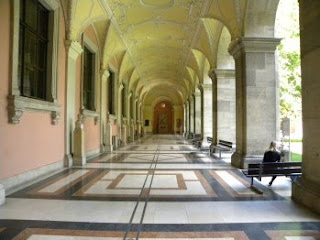
(Fountain outside Parliament.)
Until the age of twenty-seven, Freud lived with his parents in the Jewish Quarter of Vienna, a diverse community that boasted being the center of such movements as the Haskalah and Zionism.

(Judenplatz with statue of Lessing and a Holocaust memorial)
Freud's father was a poor wool merchant who wanted his son well-educated. Freud didn't disappoint, studying medicine at the University of Vienna.
(The courtyard today has busts of, among others, illustrious full professors -- a title Freud was only given by the university one year after he retired and after several decades of teaching there.)
At the age of thirty-five, Freud moved into a 4,000 square foot flat on the mezzanine floor of Berggasse #19. There, he established his psychoanalytic practice -- the family rooms and his work rooms kept strictly separated. Visitors still must ring the door bell in order to enter the flat where Freud once escorted his patients to a waiting room. Here, Freud's cane is on display behind glass.
At the designated appointment time, patients went into the consulting room and lay on Freud's famous couch. The room next to it contained Freud's study, where he purportedly smoked twenty cigar's per day, experimented with the salubrious effects of cocaine, and wrote prolifically. Freud believed that his most important work was The Interpretation of Dreams.
At the designated appointment time, patients went into the consulting room and lay on Freud's famous couch. The room next to it contained Freud's study, where he purportedly smoked twenty cigar's per day, experimented with the salubrious effects of cocaine, and wrote prolifically. Freud believed that his most important work was The Interpretation of Dreams.


(Above is the waiting room, renovated to look exactly as it did when Freud lived here. Below, the consulting room houses pictures and manuscripts only.)
I defensively add (no introjection or projection intended) that Vienna hasn't commemorated the places outside this home where Anna might have lingered. Only Freud seemed to get out, wandering through the streets of Vienna until the age of 62 as a subject of the Habsburg Monarchy. He enjoyed walking along Ringstrasse (including where the fountain above exists). He wasn't one to sloth around at cafe's, but he infrequently visited Landtmann:

(I had the double espresso, orange liquor, and whipped cream delight called the Maria Theresa.)
He also would stop at the behemoth Kunsthistorisches Museum. An avid collector of antiquities, he regularly scoured the city for ancient collectibles. Freud wasn't a blank slate to his patients -- he had over 2,500 copies of statues from ancient civilizations scattered across his work rooms, some even on the floor for lack of space.
Today, the cigar smell on Berggasse is gone and so is the couch. In 1938, at the age of eighty-two, Freud fled the Nazi's and went to London. Only in 1971 did Anna return to establish the Freud Museum. She brought with her a smattering of Freud's items and established the Sigmund Freud society.
Freud's legacy is everywhere in Vienna, plaques advertising psychoanalytic practices on many blocks:
Freud's legacy is everywhere in Vienna, plaques advertising psychoanalytic practices on many blocks:
The brighest testimony to Vienna's love of Freud is the Sigmund Freud park, located only a few blocks from his former residence. Here, anyone can take a few of the city lawn chairs and, surrounded by trees and grass, dream their day away.




1 comment:
What a wonderful article and photos! Thank you, I enjoyed it very much and learned alot I didn't know. Valorie
Post a Comment